 username@email.com
username@email.com
In this lesson, you will review plant growth, mechanisms, relationships, reproduction, and environmental responses.
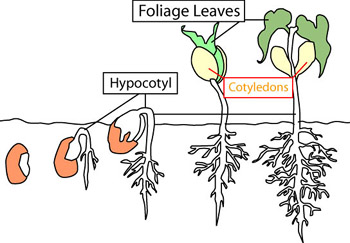
A plant begins life after double fertilization occurs within the ovary of a flower. As cells divide by mitosis, an embryo and endosperm form. Then, the layers of tissue surrounding the embryo and endosperm toughen and become impermeable to water and oxygen. This causes the embryo to stop growing and a mature seed forms.
At some point, the plant embryo will begin growing again. This is called germination. Before germination can occur at all, water and oxygen must penetrate the seed coat. This results in the breaking of the seed coat. Many plants require heat or cold to germinate; still others require exposure to light. The first visible evidence of this process is the emergence of the embryonic root. Then the shoot will elongate and emerge from the soil. The leaves will then push through, unfurl, and begin to photosynthesize. Eventually, the food supply stored in the cotyledons is depleted, causing them to shrivel up and fall off.
The first sign of germination of a bean seed is the emergence of the
C is the correct choice. The shoot is the second structure to appear. The cotyledon is the third structure to appear. The endosperm is part of the seed formation process.
Plants grow by cell division that occurs in meristems located at the tips of the shoots and roots. This type of growth is called primary growth. It occurs in apical meristems, which are located at the tips of stems and roots, just behind the root cap. The area where the cells grow larger is the zone of elongation; farther back from this is the zone of maturation. In this zone, cells differentiate into the various cells making up the stem. The tissue produced is primary tissue.
Primary growth also pushes roots through the soil. The root tip is covered by a root cap. Growth in length is concentrated near the root tip. In the roots, meristems give rise to primary tissues:
Most plants undergo secondary growth, in which the plant increases in width as well as length. The tissues that result from this growth are secondary tissues. The effects of secondary growth are most dramatic in woody plants. Two lateral meristems function in this process: vascular cambium and cork cambium. Cell division in the lateral meristems adds layers of new cells around the outside of the plant’s body.

The vascular cambium produces xylem and phloem. This layer is just beneath the bark. Xylem is produced in the interior of the vascular cambium and phloem is produced in the exterior. The new ring of xylem tissue formed every growing season and the older xylem become the wood of trees. Older xylem layers are dead, yet can still conduct water for several years. The phloem layer is never as thick as the xylem layer. Phloem tissue forms the inner half of tree bark.
The cork cambium lies within the bark of a woody stem. It produces the cork cells of the outer bark. Cork tissue functions as a barrier that helps protect the stem from physical damage and pathogens. The layers of cork tissue and the cork cambium make up the periderm, which is the protective coat of the secondary plant body that replaces the epidermis of the primary plant body.
The lateral meristems also develop and produce secondary growth in the roots. The vascular cambium forms within the stele and produces xylem and phloem. As the stele grows, the epidermis is split and shed. A cork cambium forms from the pericycle of the stele and produces periderm, which will become the secondary dermal tissue.
Cell division that results in the increased width of a tree occurs in the
The correct choice is A; cell division in the lateral meristems occurs in secondary growth which increases the length and width of a tree. Apical meristems are responsible for cell growth at the tips of roots and shoots. Primary tissues form leaves, roots, fruit pulp, and stem pith. Sieve tube vessels are part of the food-conducting phloem.
Plants are classified into three main groups depending on how long it takes them to produce flowers and how long they live.
Hormones control the division, growth, maturation, and differentiation of plant cells. They are manufactured primarily in apical meristems, in young leaves, and in growing seeds and developing fruits. Plant hormones control a plant’s branching pattern, the rate at which its stems elongate, and its responses to environmental conditions.
Auxin in the stems causes the stem to grow toward light and away from the pull of gravity. High concentrations of auxin stimulate young stem cells to elongate. Auxin in the roots causes the roots to grow away from light and toward the pull of gravity. High concentrations of auxin inhibit root cell elongation. Auxin also can cause cell division in meristematic regions to stop or start. Finally, the high concentration of auxin produced by the apical meristem inhibits the growth of lateral buds near the tip of the shoot.
Cytokinins are manufactured by the growing roots. They stimulate cell division and cause dormant seeds to sprout. Several of the effects produced by cytokinins are the opposite of effects produced by auxins.
Gibberellin is manufactured by all higher plants. It stimulates growth in leaves and stems, but not in the roots. In stems, gibberellin stimulates cell elongation and cell division. It can also signal seeds to break dormancy and begin germination.
What is the hormone that controls the growth of plant roots?
The correct choice is B. Gibberellin is responsible for leaf and stem growth. Auxin is responsible for stem elongation. Glucose is not a hormone; it is a product of photosynthesis and fuels plant processes.
Plants convert the energy of sunlight into the energy in the chemical bonds of carbohydrates (sugars and starches) in a process called photosynthesis. The overall process can be summarized by the following chemical equation:
CO2 + H2O + light → C6H12O6 + O2
Photosynthesis occurs primarily within leaves. Cells in the leaves contain chloroplasts, which contain chlorophyll. Chlorophyll is the light-absorbing substance needed for photosynthesis.
Photosynthesis requires:
The stages of photosynthesis are:
Photosynthesis produces
Hope you chose D, because the products of photosynthesis are glucose and oxygen. Photosynthesis does not produce carbon dioxide, water, or alcohol.
The process of photosynthesis is divided into two parts: light reactions and dark reactions. The light reactions require light. In these reactions, the energy of sunlight is captured and used to make energy-storing compounds. The light reactions occur in the photosynthetic membranes of chloroplasts. The light reactions can be divided into four basic processes: light absorption, electron transport, oxygen production, and ATP formation. These processes are closely linked and dependent on each other.
The photosynthetic membrane contains clusters of pigment, or photosystems. There are two photosystems in green plants. Each one contains hundreds of chlorophyll molecules, as well as other pigments. The other pigments absorb light in the regions of the spectrum that chlorophyll does not. This causes electrons in pigment molecules to be raised to an excited state. Only a special pair of chlorophyll molecules can process the light energy.
The high-energy electrons produced in the previous process travel from a special pair of chlorophyll molecules to an adjacent molecule called an electron carrier. This begins electron transport. The high-energy electrons are transferred along a series of electron-carrier molecules in the photosynthetic membrane. At the end of the chain, an enzyme passes the high-energy electrons to an electron carrier called NADP +, which is converted into NADPH. Adding a pair of electrons to this electron carrier requires energy. The energy and electrons stored in the bonds of NADPH will be used later on in the overall process.
As the light continues to shine, the photosynthetic membrane contains a system that provides new electrons to chlorophyll to replace the ones that converted to NADPH. These electrons are taken from water. Four electrons are removed from two water molecules, leaving four hydrogen ions and two oxygen atoms. The two oxygen atoms combine to form oxygen gas that is eventually released into the air.
The hydrogen ions left behind when water is “split” are released into the photosynthetic membrane. In addition, more hydrogen ions are pumped across the membrane as electrons are passed from chlorophyll to NADP +. Eventually, an enzyme attaches a phosphate molecule to ADP, forming ATP. This is the second way in which the energy of sunlight is trapped in chemical form. These energy-storing molecules will be converted to a more convenient form during the dark reactions.
The oxygen that results from photosynthesis comes directly from the
B is the correct choice, because after the water molecules are split, the resulting two oxygen atoms combine to form oxygen gas. Choices A, C, and D do not produce oxygen.
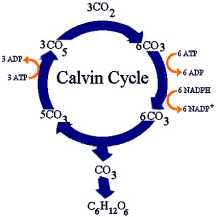
The dark reactions generally take place in sunlight; however, light does not play a role in the dark reactions. In this part of photosynthesis, carbon dioxide is used to make a complex organic molecule. The dark reactions form a cycle, or circular series of reactions. The dark reactions are also known as the Calvin cycle.
The Calvin cycle employs a complex battery of enzymes that are found in the stroma of a chloroplast . Photosynthesis itself usually occurs in the thylakoid membranes of a chloroplast. A total of six carbon dioxide molecules must enter the Calvin cycle to produce one six-carbon sugar molecule. The Calvin cycle takes place in five steps.
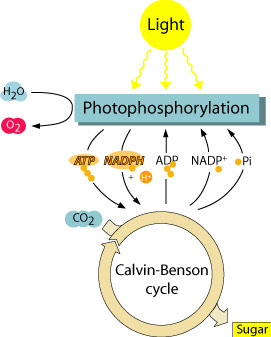
Finally, photosynthesis and another process called cellular respiration form a continuous cycle, because the products of one process are the starting materials for the other.
Which of these is produced by the dark reactions?
D is the correct choice, as glucose is produced in the Calvin cycle dark reaction. Oxygen and ATP are produced in the Calvin cycle light reaction. Water is required for, not produced by, photosynthesis.
There are several examples of symbiotic relationships among plants and other organisms, including:
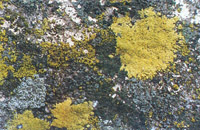 |
Lichens are symbiotic relationships between a fungus and a photosynthetic organism, usually algae. In this partnership, the alga carries out photosynthesis, providing the fungus with a source of organic nutrients. The fungus, in turn, provides the alga with water and minerals that it has collected from the surfaces on which it grows. |
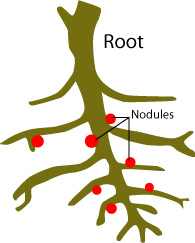 |
Mycorrhizae are symbiotic relationships between plant roots and fungi. The fungal filaments aid in the direct transfer of phosphorus and other minerals from the soil into the roots of the plant, while the plant supplies carbohydrates to the fungus. Over 95% of all vascular plants have mycorrhizae. This type of symbiotic relationship is an example of mutualism. |
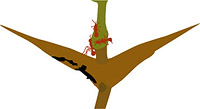 |
Certain species of Central and South American acacia trees have hollow thorns that house stinging ants. The ants feed on sugar produced by nectaries on the tree. The acacia benefits from the housing and feeding of the ants, because the ants attack everything that touches the tree. The ants sting other insects, remove fungal spores and other debris, and clip surrounding vegetation that happens to grow close to the foliage of the acacia. |
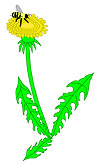 |
Some angiosperms have adaptations that attract animals that function in pollination or seed dispersal. For example, pollen is spread when the pollinator consumes nectar, and seeds are dispersed by animals that eat the fruit that encloses them. |
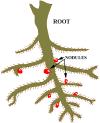 |
Many plant families include species that form symbiotic relationships with nitrogen-fixing bacteria that give roots a built-in source of fixed nitrogen for assimilation into organic compounds. This is especially common in the legume plant family, which includes peas, beans, soybeans, peanuts, alfalfa, and clover. Nodules on the roots contain the bacteria. Meanwhile, the plant provides the bacteria with carbohydrates and other organic compounds. |
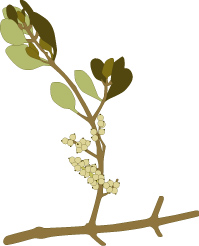 |
Lichens are symbiotic relationships between a fungus and a photosynthetic oMistletoe lives as a parasite on oaks and other trees. Mistletoe is photosynthetic, but it supplements its nutrition using projections to siphon xylem sap from the vascular tissue of host trees. |
Mycorrhizae are symbiotic relationships of fungi and
The correct choice is C. Mycorrhizae are mutualistic relationships between fungi and plant roots. Mycorrhizae do not occur in algae, lichens, or chloroplasts.
The life cycles of most algae include both a diploid and a haploid generation. Diploid cells have the normal number of chromosomes for a species, whereas haploid cells only have half the number of chromosomes. Most species of algae reproduce by alternation of generations.
A species called Chlamydomonas usually reproduces asexually by mitosis. However, if conditions become unfavorable, it can switch to a stage that reproduces sexually.
Mosses generally reproduce by alternation of generations. They can reproduce sexually only when standing water is present. Some species have both male and female reproductive organs on one gametophyte; other species have male and female reproductive structures on separate gametophytes.
Ferns reproduce through alternation of generations, as well. Sexual reproduction in ferns depends upon the presence of standing water for sperm to swim to eggs. The same individual produces both the eggs and sperm.
Familiar gymnosperms, such as pine trees, are diploid sporophytes. The male cones carry structures called microsporangia, which produce pollen grains. The female cones carry structures called megasporangia, which produce female gametophytes. The female gametophytes produce ovules, in which egg cells form.
Pollen grains are carried by wind to female cones, where they land near an ovule. The grain splits open and grows a pollen tube, which grows into the ovule. Eventually, the sperm inside the tube break out. One fertilizes the egg and the other disintegrates. The resulting zygote will eventually become an embryo encased in what later develops into a seed.
A pine tree will produce both male and female cones on the same individual.
Like all other types of plants, angiosperms reproduce by alternation of generations. However, angiosperms have evolved a specialized plant structure to help them with sexual reproduction: the flower.
Located in each plant ovary are ovules. The ovules produce female gametophytes, which are embryo sacs containing eight nuclei. These gametophytes are smaller than that of mosses and ferns. The nuclei move around and eventually the nucleus closest to the ovule opening enlarges to become the egg nucleus. The gametophyte is now ready for fertilization.
The male gametophyte is smaller than the female gametophyte. Inside the anthers, pollen chambers produce microspore cells. The microspore cells ultimately become pollen grains. The pollen grains usually stop growing until they are deposited on a stigma. Eventually, the anther dries out; its pollen chambers split open; and mature pollen grains are released.
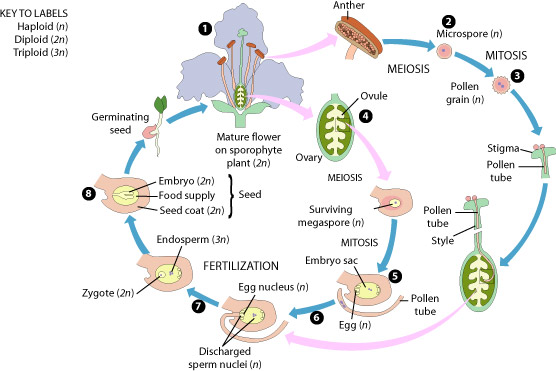
Just like gymnosperms, fertilization begins after the pollen tube has reached the embryo sac and the sperm nuclei enter. Then, double fertilization occurs. Following this, parts of the ovule toughen to form a seed coat. The ovary wall thickens and joins with other parts of the flower stem to become the fruit that holds the seeds.
The reproductive organs of gymnosperms are
The correct choice is C. Gymnosperms do not have fruits, ferns, or flowers.
Plants respond to their environment in various ways. Obvious examples are when a plant’s leaves wilt due to a drought or a plant dies due to the presence of herbicide. A plant’s response to its environment generally falls into one of the following categories:
A tropism is a growth response in which the direction of growth is determined by the direction from which the stimulus comes. Auxins are responsible for producing tropisms. If the plant grows toward the stimulus, it is a positive tropism. If the plant grows away from the stimulus, it is a negative tropism. Three common tropisms that plants respond to are phototropism, gravitropism, and thigmotropism.
| Phototropism is a plant’s growth response to light. The plant’s shoot tip is the site of the photoreception that triggers this growth response. The growth of a plant’s shoots toward light is positive phototropism, while the growth of roots away from light is negative phototropism. | 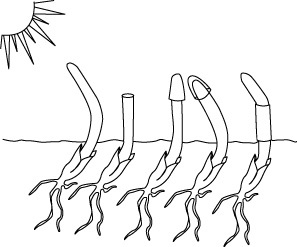 |
| Gravitropism is a plant’s growth response to gravity. Roots display positive gravitropism by curving downward, and shoots display negative gravitropism by bending upward. Gravitropism functions as soon as a seed germinates. | 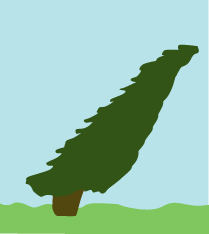 |
| Thigmotropism is growth responses to touch. For example, vines and climbing plants have tendrils that coil around supports. They usually grow straight until they touch something; the contact stimulates a response. Mechanical stimulation, such as rubbing stems with a stick, can also cause a response. The response is usually a shorter plant. | 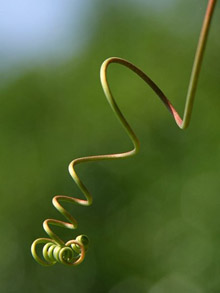 |
Dormancy is a condition in which a seed or a plant remains inactive for a period of time. It is thought that plant hormones play a role in initiating dormancy. Seeds often remain dormant for a period before germination. Plants also exhibit winter dormancy by their leaves changing to autumn colors and eventually falling off.
Photoperiodism is the response of plants to the lengths of days and nights. Plants can be categorized as one of three types, depending on how they respond to day length. Short-day plants, such as the goldenrod, need long periods of darkness for flowering. Long-day plants, such as the iris, need short periods of darkness to induce flowering. Day-neutral plants, such as corn, are plants that are not affected by day length. This results in some plants flowering in spring, some in summer, and others in the fall.
The part of most terrestrial plants that shows positive phototropism and negative gravitropism is a
The correct choice is D, because the hormone auxin causes stems to grow upward (away from gravity) and toward light. Vascular bundle, roots, and flowers are not subject to this hormonal control.